Input interpretation

decane
Chemical names and formulas

formula | CH_3(CH_2)_8CH_3 Hill formula | C_10H_22 name | decane alternate names | alkanes, c10-18 | (c10-c18) alkanes | N-decane mass fractions | C (carbon) 84.4% | H (hydrogen) 15.6%
Lewis structure
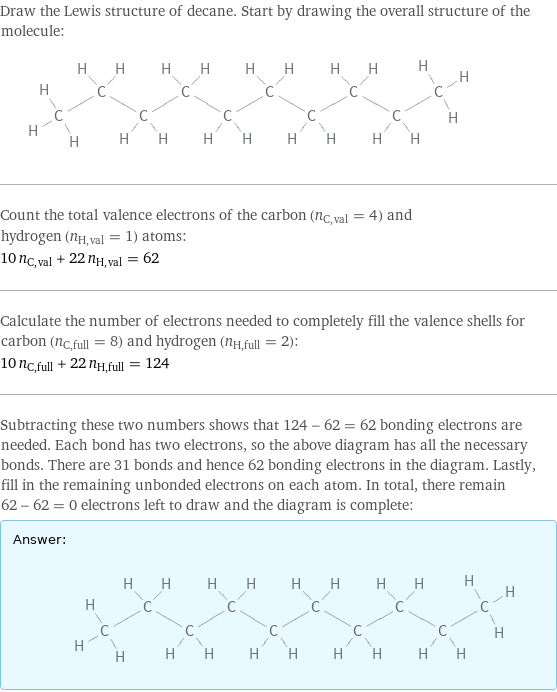
Draw the Lewis structure of decane. Start by drawing the overall structure of the molecule: Count the total valence electrons of the carbon (n_C, val = 4) and hydrogen (n_H, val = 1) atoms: 10 n_C, val + 22 n_H, val = 62 Calculate the number of electrons needed to completely fill the valence shells for carbon (n_C, full = 8) and hydrogen (n_H, full = 2): 10 n_C, full + 22 n_H, full = 124 Subtracting these two numbers shows that 124 - 62 = 62 bonding electrons are needed. Each bond has two electrons, so the above diagram has all the necessary bonds. There are 31 bonds and hence 62 bonding electrons in the diagram. Lastly, fill in the remaining unbonded electrons on each atom. In total, there remain 62 - 62 = 0 electrons left to draw and the diagram is complete: Answer: | |
3D structure

3D structure
Basic properties
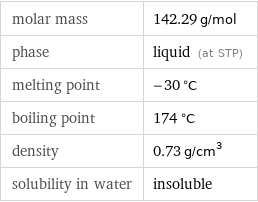
molar mass | 142.29 g/mol phase | liquid (at STP) melting point | -30 °C boiling point | 174 °C density | 0.73 g/cm^3 solubility in water | insoluble
Units

Liquid properties (at STP)
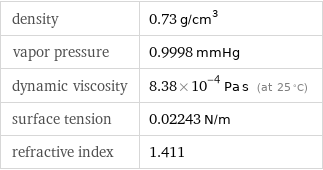
density | 0.73 g/cm^3 vapor pressure | 0.9998 mmHg dynamic viscosity | 8.38×10^-4 Pa s (at 25 °C) surface tension | 0.02243 N/m refractive index | 1.411
Units

Thermodynamic properties
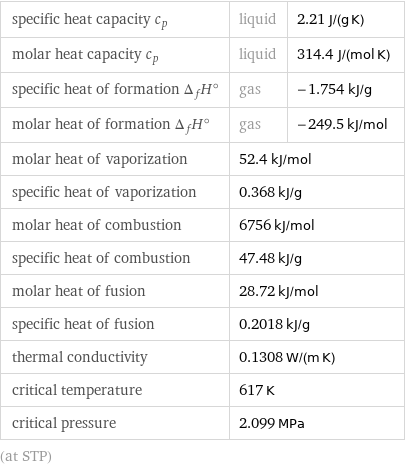
specific heat capacity c_p | liquid | 2.21 J/(g K) molar heat capacity c_p | liquid | 314.4 J/(mol K) specific heat of formation Δ_fH° | gas | -1.754 kJ/g molar heat of formation Δ_fH° | gas | -249.5 kJ/mol molar heat of vaporization | 52.4 kJ/mol | specific heat of vaporization | 0.368 kJ/g | molar heat of combustion | 6756 kJ/mol | specific heat of combustion | 47.48 kJ/g | molar heat of fusion | 28.72 kJ/mol | specific heat of fusion | 0.2018 kJ/g | thermal conductivity | 0.1308 W/(m K) | critical temperature | 617 K | critical pressure | 2.099 MPa | (at STP)
Phase diagram

Phase diagram
Units

Basic drug properties

approval status | experimental | small molecule
Hydrophobicity and permeability properties
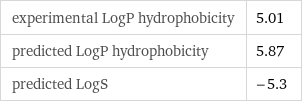
experimental LogP hydrophobicity | 5.01 predicted LogP hydrophobicity | 5.87 predicted LogS | -5.3
Chemical identifiers
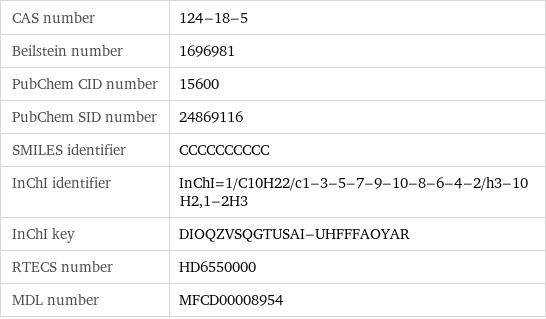
CAS number | 124-18-5 Beilstein number | 1696981 PubChem CID number | 15600 PubChem SID number | 24869116 SMILES identifier | CCCCCCCCCC InChI identifier | InChI=1/C10H22/c1-3-5-7-9-10-8-6-4-2/h3-10H2, 1-2H3 InChI key | DIOQZVSQGTUSAI-UHFFFAOYAR RTECS number | HD6550000 MDL number | MFCD00008954
NFPA label

NFPA label